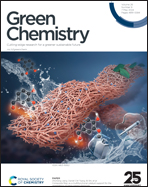Interaction between copper and nickel species for electrooxidation of 2,5-bis(hydroxymethyl)furan†
Abstract
2,5-Furandicarboxylic acid (FDCA) is an important bio-derived monomer to produce poly(ethylene 2,5-furandicarboxylate) (PEF), known for its superior gas barrier properties in comparison with the widely used poly(ethylene terephthalate) (PET). Among the various synthesis routes to FDCA, electrocatalytic oxidation of furan precursors is an attractive choice due to its great energy efficiency with hydrogen as the co-product. With the aim of efficiently producing FDCA and H2, we employed an electrodeposition and subsequent oxidation method to synthesize nickel–copper alloy catalysts for the electrolysis of 2,5-bis(hydroxymethyl)furan (BHMF). The optimized Ni7Cu3 catalyst exhibited a remarkable FDCA yield of 99.8% at nearly complete conversion of BHMF. In situ Raman spectroscopy revealed that Ni3+ species served as the active sites during the BHMF oxidation. Surface copper oxide facilitated the maintenance of the high valence state of Ni3+ during the reaction. The superior electrical conductivity of Cu compared to Ni boosted the transport of electrons from reactant molecules through the catalytic layer and collector to the outer circuit. The addition of nickel not only enhanced the catalytic activity of copper foam but also contributed to slowing down of the leaching of copper during electrolysis. This work provides novel insights into the mechanistic elucidation of alloy catalysts for biomass electrooxidation.



 Please wait while we load your content...
Please wait while we load your content...